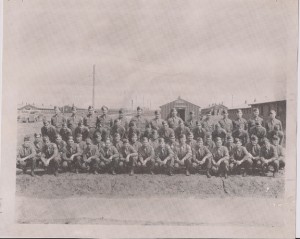 Alliance Municipal Airport was built during World War II by the United States Army Air Force. It was one of eleven United States Army Air Force training airfields in Nebraska during World War II. On April 14, 1942, the Secretary of War authorized the establishment of the field. It was constructed between the summer of 1942 and August 1943. The 4,205-acre (17.02 km2) site is bordered by low rolling sandhills to the east, and a wide plain on the north, west and south.
Alliance Municipal Airport was built during World War II by the United States Army Air Force. It was one of eleven United States Army Air Force training airfields in Nebraska during World War II. On April 14, 1942, the Secretary of War authorized the establishment of the field. It was constructed between the summer of 1942 and August 1943. The 4,205-acre (17.02 km2) site is bordered by low rolling sandhills to the east, and a wide plain on the north, west and south.
During the construction of the airfield over 5,000 workers came from all over the country, causing a housing shortage. The population of Alliance doubled almost overnight. Workers moved into garages, store rooms, cellars, attics, and even their own trailers in established parks. The cantonment housing area of the airfield covered 1,088 acres, and supported 775 buildings and other structures. Some were built of brick and steel, such as aircraft hangars. However most were of frame construction, sitting on top of poured concrete foundations. Tar paper and 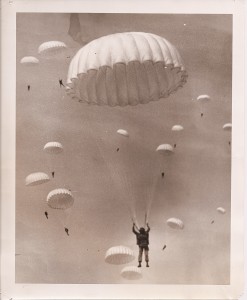 plywood were generally used for walls and flooring, as the buildings were considered temporary at best, only to be used for a few years. In addition, the airfield utilized a railroad spur, power plant, waterworks, and sewage system, as well as a total of 35,503 feet of runways. The airfield had been planned as a training facility for paratroops and air commandos, which needed long runways for C-47 Skytrains to tow gliders.
plywood were generally used for walls and flooring, as the buildings were considered temporary at best, only to be used for a few years. In addition, the airfield utilized a railroad spur, power plant, waterworks, and sewage system, as well as a total of 35,503 feet of runways. The airfield had been planned as a training facility for paratroops and air commandos, which needed long runways for C-47 Skytrains to tow gliders.
On August 22, 1943, a huge crowd of 65,000 people gathered for the dedication of the newly constructed Alliance Army Airfield. The mission of the airfield was to provide a training facility for Army paratroops and air crews. Between the opening of the airfield and the spring of 1944, the I Troop Carrier Command, 434th Troop Carrier Group commanded the airfield. The 411th Army Air Force Base Unit commanded the support elements at Alliance as part of Air Technical Service Command. In addition to the C-47s, the unit repaired B-17 Flying Fortress and B-24 Liberator aircraft from other airfields.
The airfield was home to as many as 14,000 paratroops in the area, using C-47 Skytrains as powered troop carriers, and CG-3/CG-4 Waco glider troop carriers for their training aircraft. The sandhills were thought to provide a softer landing than wooded areas for jumping paratroops.
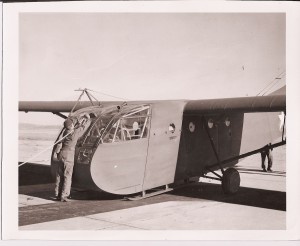 Known units that trained at Alliance AAF were: 403d Troop Carrier Group (December 18, 1942 – May 3, 1943) 434th Troop Carrier Group (9 February 1943 – 5 September) 436th Troop Carrier Group (May 2 – August 1, 1943) 439th Troop Carrier Group (June 1 – December 16, 1943) 440th Troop Carrier Group (September 7, 1943 – January 4, 1944) 442d Troop Carrier Group (December 1943 – January 1944) 349th Troop Carrier Group (January 19 – March 8, 1944) 443d Troop Carrier Group (January 19 – February 15, 1944) 10th Troop Carrier Group (March 8 – April 14, 1944).
Known units that trained at Alliance AAF were: 403d Troop Carrier Group (December 18, 1942 – May 3, 1943) 434th Troop Carrier Group (9 February 1943 – 5 September) 436th Troop Carrier Group (May 2 – August 1, 1943) 439th Troop Carrier Group (June 1 – December 16, 1943) 440th Troop Carrier Group (September 7, 1943 – January 4, 1944) 442d Troop Carrier Group (December 1943 – January 1944) 349th Troop Carrier Group (January 19 – March 8, 1944) 443d Troop Carrier Group (January 19 – February 15, 1944) 10th Troop Carrier Group (March 8 – April 14, 1944).
In addition to the USAAF units, the Army 326th Glider Infantry, 507th Parachute Infantry, and 878th Airborne Engineers trained at Alliance before deployment to the European Theater showing the paratroopers how to jump. As paratroopers flooded into Alliance, housing was at a critical shortage. In order to relieve the housing stress, a federal housing project was constructed at the east end of Alliance, consisting of apartment complexes with plain stucco walls, coal heating stoves, and rows 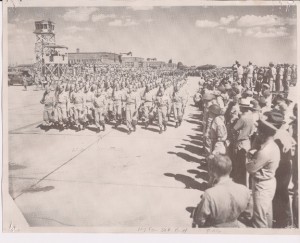 of chimneys along the rooflines, thus inspiring the name “Chimney Town.”
of chimneys along the rooflines, thus inspiring the name “Chimney Town.”
After the paratroops left Alliance, Second Air Force temporarily used the Alliance airfield in the fall of 1944 for the training of B-29 Superfortress crews. Training included teaching the B-29 air crews how to drop bombs and read navigational, aeronautical and bombsight equipment. Finally, in the summer of 1945, the 1st Troop Carrier Command returned to the airfield to train for the proposed invasion of Japan. That necessity ended when Japan surrendered on September 6. On October 31, 1945, the Army Air Force “temporarily” deactivated the Alliance Army Airfield. Control of the airfield was assigned to Air Technical Service Command at Ogdon Army Airbase, Utah. Though speculation was that the Army would make the huge Alliance airfield a permanent installation, by November 20 the Troop Carrier Command closed the facility permanently and began to make plans to sell the surplus property.
By December 1945 the facility was declared surplus property. Nonetheless, its status remained in limbo. The city of Alliance showed interest in acquiring the facility. However, in the fall of 1946 Nebraska congressman A. L. Miller stated that the airfield 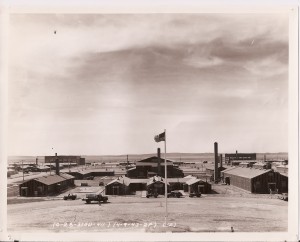 would be withdrawn from the surplus list to be reactivated for Troop Carrier Command training, in response to strained relations with the Soviet Union. This did not happen, however, and the U. S. Government negotiated a disposition agreement for the facility. Due to disputes between the U.S. government and the city of Alliance, the final disposition of the airfield did not occur for many years, and in the meantime, the government removed the railroad tracks and auctioned off 240 buildings, including lavatories, guard houses and barracks. Finally, on July 16, 1953, the city of Alliance and the federal government finalized the transfer for the land and buildings which were to become the Alliance Municipal Airport. Today a large number of World War II-era buildings remain in use.
would be withdrawn from the surplus list to be reactivated for Troop Carrier Command training, in response to strained relations with the Soviet Union. This did not happen, however, and the U. S. Government negotiated a disposition agreement for the facility. Due to disputes between the U.S. government and the city of Alliance, the final disposition of the airfield did not occur for many years, and in the meantime, the government removed the railroad tracks and auctioned off 240 buildings, including lavatories, guard houses and barracks. Finally, on July 16, 1953, the city of Alliance and the federal government finalized the transfer for the land and buildings which were to become the Alliance Municipal Airport. Today a large number of World War II-era buildings remain in use.